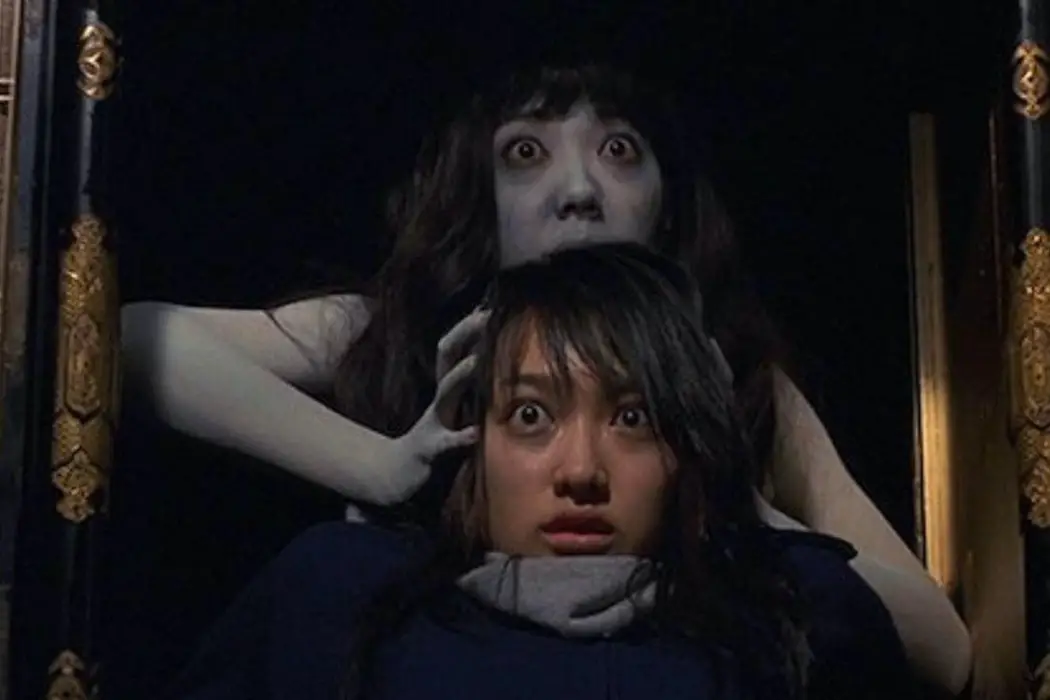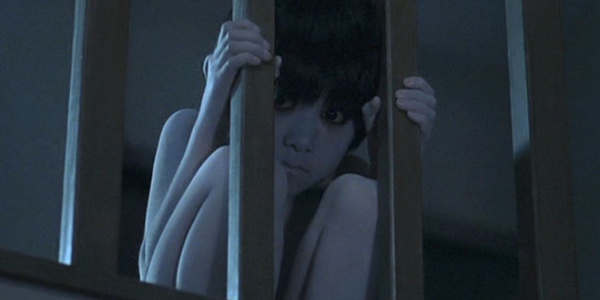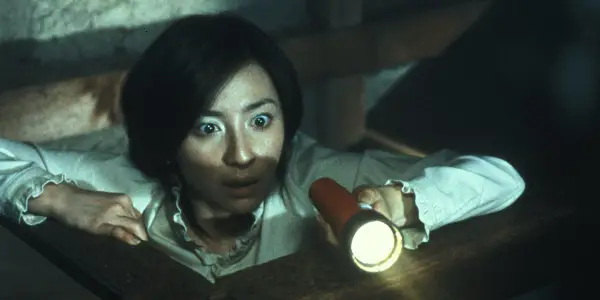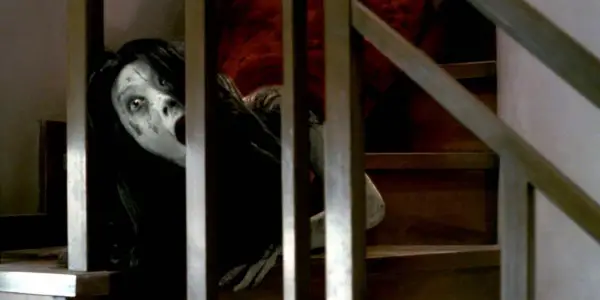Horrific Inquiry: JU-ON: THE GRUDGE (2002)

Stephanie Archer is 39 year old film fanatic living in…
Welcome back to the newest, and at times goriest, column here at Film Inquiry: Horrific Inquiry. Twice a month, I will be tackling all things horror, bringing two films back into the spotlight to terrify and frighten once more. And occasionally looking at those that could have pushed the envelope further. Join us as we dive deep into the heart of horror, but warning, there will be spoilers.
There is nothing like a curse and a haunting to bring the thrills and terror to a motion picture. Mystery and murder from the paranormal making for unpredictability and chaos within the normalcy of everyday living. Usually encased within a home, person or object, there is little control as the world of those cursed is upended. For Ju-on, the curse finds itself rooted within a home, the powerful rage created by gruesome and violent murders giving this haunting a terrifying face.
Yet, where many curses and haunted homes find their influences constrained within the invisible lines of property ownership, Ju-on breaks free of the predetermined barriers set forth by previous films. For Ju-On, the curse infects its victim, the terror of Kayako (Takako Fuji) and Toshio (Yuya Ozeki) unrelenting.
While Ju-on would launch a franchise – spearheaded several times around by director Takashi Shimizu – its placement within the J-horror sub-genre is undeniable. As an avid horror fan myself, I started my venture into J-horror with Kiyoshi Kurosawa‘s Kairo (Pulse), a film whose aesthetic is clearly an influence here. Though do not be mistaken, Ju-On has its own identity – and a horror – all its own.
A Terrifying J-Horror Introduction
A curse is not a curse without its origins. Ju-on opening to a grainy black and white visual; quick glimpses are edited together to give a picture to the gruesome and violent murder of Kayako and Toshio by father and husband Takeo Saeki (Takashi Matsuyama). As we see and hear the opening play out, the score further heightening the intensity, Ju-on drives the rage-driven crime to life. It is an uneasy opening, close-ups capturing glimpses of the violence and the anger that would engulf and transfer to Kayako and Toshio – as well as the household cat.

Abruptly leaving the grainy and terrifying beginning of the film, Ju-on transfers its focus to the present, starting its devastating six part breakdown with Rika (Megumi Okina), color flooding the senses. While there are those around them who fall victim to the grudge as well, these six are the central figures our story pivots around. Rika is assigned by the welfare center to go and care for Sachie (Chikako Isomura), an elderly woman at the Tokunaga household, as the former aid was given a key, but never returned with it. Reluctant to go, she makes her way to the Tokunaga residence, finding the elderly woman soiled and abandoned.
There is a quiet eeriness that is established early on as you take in the setting and staging of the home, items and garbage thrown everywhere. The house appears to be recently abandoned and unkept, leaving viewers to question not only the state of the elderly woman but of the events that seem to surround her. While Rika cleans up Sachie, she begins to clean the house as well, her tasks bringing her to the second floor. It does not take long for the intensity to heat up, a photograph with a woman’s face cut out meeting the ominous scratching noises coming from a closet upstairs.
The film’s volume levels and balance are adjusted, seemingly making the scratching noises sound as though they are primarily coming from the left, this effect most noticeable in an intimate headphone setting. It gives the audience a sense of immersion within the film, as if the action is coming at us ourselves — as if Toshio is right beside us. As we watch Rika slowly making her way across the second floor, her presence in the home already her doom, this playfulness of the scores balances and heightens every level of intensity Ju-on is ready to effectively establish and build on.

As Rika enters the room, there is the undeniable feeling that something is wrong, the camera quickly taking in the barricaded doors and closet sealed with tape. This is the strongest influence from Kairo within the film. In Kairo, red tape is used to mark where all the haunted places are. Removing the tape allows for the haunting to come forth. For Ju-On, Rika peels the tape back, opening the closet door, the sounds of a cat met with one inside. As she leans in to coax the cat out, a young boy appears next to her. For Rika, this discovery leads her down a terrifying path, one that brings her directly to the face of rage.
No Boundaries
What is interesting about Ju-on is not only its brilliantly crafted horror or its tantalizing narrative of rage but its idea of boundaries – or lack thereof. For many hauntings and curses, there are rules that are expected and followed. It adds to predictability, but also gives a framework for authenticity and believability. Ju-on turns its back on the idea, keeping the film not only unpredictable but rooting its fear within the uncertainty of the curse and those who carry it out.
An unforgiving curse, it knows no limits. It is not limited by the power technology, rather embracing it and utilizing it to horrifying effects. Security cameras capture Kayako as she kills the security guard, the camera as savvy as the keen eye. Telephones ring with the spine-chilling call of the spirit about to strike. And TV broadcasts are transformed into eerie images (emulating strong Ring vibes), the sound finding its way out through distortion.

Returning to the security guard, he is another form of Ju-on’s defiance of “the rules”. Per the understanding of the grudge, all who enter the home fall victim to its powerful rage. Not immediately mind you, but all do succumb in the end. However, for the security guard at Hitomi’s (Misaki Itô) job, he did not enter the home. He wasn’t even near it. He just happened to be at the wrong place at the wrong time. There is a collateral damage aspect that could not be foreseen. As the security guard makes his way to check on Hitomi’s reported incident, there is the assumption he will not see anything. Even as the shadow slowly emerges from the bathroom, there is the belief in the rules, that it will slip by him undetected, Hitomi the only sensible and viable target according to the rules. But he is not immune, and we as an audience are left in shock.
The curse also seems to transcend timelines. Where Ju-on itself is broken into varying times of narrative, so too is the curse. Time itself is broken and wielded as a tool of rage, giving its victims a view into the future and even the past, allowing them to see what is to come in order to draw them closer into the heart of the house and to effectively terrify both character and audience. Its distorting nature of a nonlinear structure only further heightens the experience for the audience as well, the off-filtering execution effective and memorable.
Conclusion
Ju-on leaves the end open for a sequel – sequels that would most certainly come. As Rika is forced to return to the house, there is the idea of a curse recycling itself, of retaining a need to stay alive, giving it a heartbeat and immortality all at once. As it works through its rage and madness, it finds itself in others, their inevitable doom a source of continuance. With each kill, Ju-on leans further into the shock value, allowing viewers to see more and more of Kayako, and allowing the sharp and horrific movements to meld with the projections thus far. This is a film that works to build its visual terror, never revealing too much too quickly, and making it a horrific payoff in the end. More often than not, the terror is in the screams of its victim and not in what they are seeing.
An unforgiving and relentless curse, Ju-on delivers on its promise to terrify – even long after the movie has ended.
Have you seen Ju-On? What did you think? Let us know in the comments below!
Does content like this matter to you?
Become a Member and support film journalism. Unlock access to all of Film Inquiry`s great articles. Join a community of like-minded readers who are passionate about cinema - get access to our private members Network, give back to independent filmmakers, and more.












